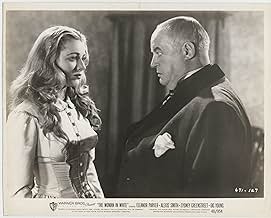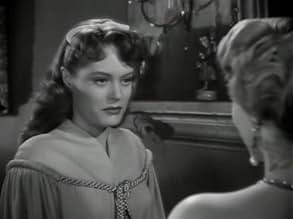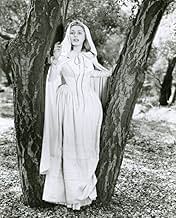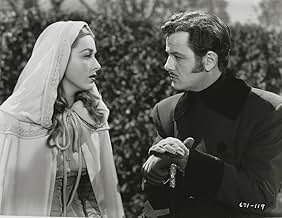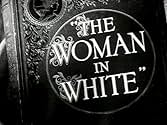Ajouter une intrigue dans votre langueA ghostly woman warns a beautiful Victorian heiress about a count, and a strange spell haunts a mansion and its inhabitants in an adaptation of Wilkie Collins' novel.A ghostly woman warns a beautiful Victorian heiress about a count, and a strange spell haunts a mansion and its inhabitants in an adaptation of Wilkie Collins' novel.A ghostly woman warns a beautiful Victorian heiress about a count, and a strange spell haunts a mansion and its inhabitants in an adaptation of Wilkie Collins' novel.
- Réalisation
- Scénario
- Casting principal
- Récompenses
- 3 victoires au total
- Attendant
- (non crédité)
- Station Agent
- (non crédité)
- Young Boy
- (non crédité)
- Underservant
- (non crédité)
- Mourner
- (non crédité)
Avis à la une
They only partly succeed, due mainly to Greenstreet's histrionic finesse as Count Fosco, seething with villainous intentions and stealing every scene he's in. Eleanor Parker, even though she has a dual role, gives one of her weaker performances as the dull heroine Laura and is only slightly more interesting in the title role. Gig Young is handsome as her suitor but looks a bit uncomfortable in his costume role.
If you like Gothic romance, you'll find plenty to admire here, especially the low-key lighting, the costumes, the quietly menacing music and the overall atmosphere of this period piece. But the resolution differs from the novel and goes for an artificially contrived happy ending.
Trivia note: When the film was released, the poster art showed all the actors in modern costumes to disguise the fact that the story took place in Victorian times. Warner Bros. frequently misled their audiences in this manner, particularly with films like DEVOTION (the Bronte sisters) showing the actresses in modern dress.
Wilkie Collins is interesting in literature because he took the model of the detective story that Poe had invented and turned it into a genre. This was not one of those, but a melodramatic story of beautiful women being menaced, and people explaining the major plot points in poorly written monologues to Miss Smith. Peter Godfrey was never one of Warner's stronger directors. What chance would he have against Greenstreet anyway? Instead, he seems to have turned the entire shoot over to DP Carl Guthrie. Every shot looks like an illustration tipped into those cheap sets of 200 Great Novels By People You Never Heard Of that could be found in every suburban home of pretension half a century ago: bound in fake leather, from slightly worn steel plates. You could write your name on the bookplate that was glued to the insider of the cover, announcing "This book is from the Library of" and then a large space, so that everyone would know this copy of ESTHER WATERS was yours, and not your brother's. If anyone wanted to know about Victorian baby farming, you were the man.
Apparently the Warner Brothers felt about this movie the way I do about that last paragraph (and ESTHER WATERS), because it sat on the shelf for a couple of years. Mind you, it's fun in a "what were they thinking?" way, and Guthrie's camerawork is amazing. Pause the film at any moment, and you get a fine image, just right for a steel-plate illustration.
Unfortunately, the movie adaptation from 1948 is a mixed bag. It stumbles early with the initial meeting of the 'woman in white' by a man on a road at night. Wilkie Collins' friend Charles Dickens considered it to be one of the most dramatic descriptions in literature, but in the film, there is no ethereal shock, and it comes across as a pretty simple meeting. The film captures the dress and language reasonably well though, and there are a couple of excellent performances - Sydney Greenstreet as the mastermind Count Fosco, and John Abbott as Frederick Fairlie, lord of the estate, who is demented, highly eccentric, and fragile. Some of his lines early on to his beleaguered servant Louis are quite funny. I should also say that Eleanor Parker is also fine in her dual role, and Alexis Smith is pretty good as her cousin too - so there are no issues with the cast.
There are two main problems as I see it, and the first is with the story itself, which asks the viewer to swallow a somewhat convoluted plot with some pretty big coincidences. What worked in installment form, or even in the published novel in 1860, is hard to translate successfully to film. The second issue is in cinematography, and overall tone. While it has a few nice moments, it's just not striking or tense enough, starting with that scene on the road at night, and continuing on through the movie. The result is that you've got a story teetering on the edge of being creaky, filmed in a way that pushes it over that edge. Watch it for the performances, or if you're a fan of the novel and want to see an old film version, maybe to compare it to the 2018 BBC mini-series version.
Except for a few grotesque close-ups of Greenstreet, director Godfrey films the scenes in straightforward fashion, as though they come straight from the pages of the Collins book. Thanks, however, to Warner's art department and set designer, the visuals come across as generally atmospheric and evocative of the period. Nonetheless, someone should have told composer Max Steiner that not every scene needs scoring, especially when the notes sound as if they thunder from the bottom of a well. Then too, the script should have made better use of the great Agnes Moorehead (just count her lines), one of the few actresses with enough gravitas to go toe-to-toe with the formidable Greenstreet. You just know at first glance, she's no one to mess with.
Somehow, I kept wishing Val Lewton ("Cat People", "Seventh Victim") had gotten hold of the material first. This movie could have used his eye for combining the literary with the uncanny, which would go beyond atmosphere to cast a much-needed hypnotic spell, particularly in Anne's outdoor scenes (the actual woman in white). As things stand, the movie's an okay entertainment, with a chance to view some of Warner's leading contract players, circa 1948.
Le saviez-vous
- AnecdotesWilkie Collins' 'The Moonstone', published in 1868, is considered to be the first modern mystery employing a crime-detecting hero.
- GaffesThe first time Ann visits Laura in her sick bed (a composite shot, as Eleanor Parker is playing both roles), her shadow is visible on the headboard. Her shadow is not synced with her head movements while talking; it rises and moves away moments before Ann herself does. Apparently, the attempt to 'imitate' Ann's shadow on Laura's half of the shot didn't quite get the timing right.
- Citations
Count Alessandro Fosco: Your proposal doesn't surprise me. Like a good general, you admit defeat when it's a fact. You're bold, you're logical. My dear, you're immensely tempting.
Marian Halcombe: Please Count Fosco, can you not say yes or no?
Count Alessandro Fosco: Let me see then. You suggest I take my ill got gains, free and then abandon my precious wife.
Marian Halcombe: Precious? The day you do so will be the day of her deliverance.
- ConnexionsReferenced in The Toxic Avenger: The Musical (2018)
Meilleurs choix
Détails
- Date de sortie
- Pays d’origine
- Langue
- Aussi connu sous le nom de
- La mujer de blanco
- Lieux de tournage
- Société de production
- Voir plus de crédits d'entreprise sur IMDbPro
- Durée1 heure 49 minutes
- Couleur
- Rapport de forme
- 1.33 : 1
Contribuer à cette page



